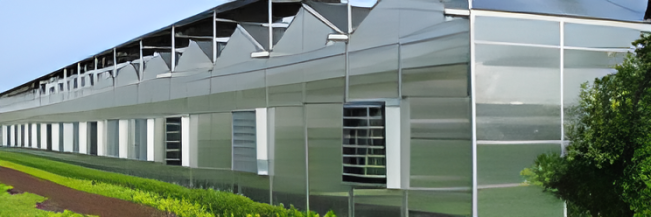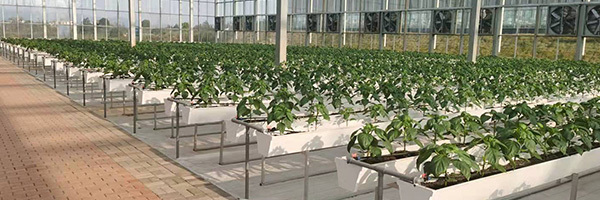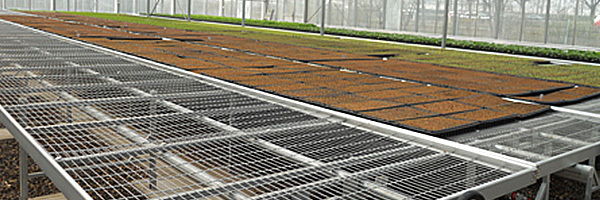-
-
Company Profile
-

Greenhouse Structures

-
Polycarbonate sheet greenhouse
-
Glass greenhouses
-
Multi-Span film greenhouse
-
Solar greenhouse
-
Sightseeing greenhouse
-
Double-film frame solar greenhouses
-
Glass and polycarbonate sheet greenhouses
-
Glass greenhouses structures suitable for planting
-
Glass Greenhouse for Scientific Research
View More -
-

-

Optimal Glass Greenhouse Structures for Effective Plant Cultivation
Release time:
2025-05-02
When considering glass greenhouse structures suitable for planting, several critical factors come into play, particularly in the fields of architectural design and material selection. Glass greenhouses are increasingly favored due to their efficiency in harnessing natural sunlight, which is a crucial component for plant growth. The ability to control environmental conditions within these structure
 When considering glass greenhouse structures suitable for planting, several critical factors come into play, particularly in the fields of architectural design and material selection. Glass greenhouses are increasingly favored due to their efficiency in harnessing natural sunlight, which is a crucial component for plant growth. The ability to control environmental conditions within these structures significantly enhances the cultivation process, making them an attractive option for both commercial and residential gardening.
When considering glass greenhouse structures suitable for planting, several critical factors come into play, particularly in the fields of architectural design and material selection. Glass greenhouses are increasingly favored due to their efficiency in harnessing natural sunlight, which is a crucial component for plant growth. The ability to control environmental conditions within these structures significantly enhances the cultivation process, making them an attractive option for both commercial and residential gardening.
One of the primary advantages of glass as a greenhouse material is its transparency. Unlike other materials, quality glass allows for optimal light transmission, ensuring that plants receive adequate sunlight throughout their growing cycles. This feature is essential for maximizing photosynthesis, which directly affects crop yields. Additionally, glass is durable and weather-resistant, providing long-term protection for plants against external elements while maintaining a stable internal environment.
In terms of design, glass greenhouses can be custom-built to meet specific planting needs. Factors such as size, height, and ventilation are paramount. A well-designed structure not only maximizes light exposure but also incorporates effective airflow systems that regulate temperature and humidity. This balance is vital for preventing mold growth and ensuring plant health. Integrating automated ventilation systems can further enhance climate control, allowing for adjustments based on real-time environmental data.
Moreover, insulation is another critical consideration when constructing glass greenhouses. While glass is an excellent insulator of light, its thermal properties can vary. Thus, selecting double or triple-glazed options can significantly improve energy efficiency. These layers help maintain internal temperatures during colder months, reducing the energy required for heating and contributing to more sustainable operations.
The structural integrity of glass greenhouses is also paramount. Using high-quality materials for framing—such as aluminum or galvanized steel—ensures that the greenhouse can withstand strong winds and heavy snow loads. Proper anchoring and foundation work are crucial to uphold the stability of these structures over time.
Lastly, the integration of smart technology in glass greenhouses represents a significant advancement in agricultural practices. Utilizing sensors and IoT devices can help farmers monitor environmental conditions, automate watering schedules, and even control shading. This approach not only minimizes labor costs but also optimizes resource use, leading to more sustainable planting practices.
In conclusion, glass greenhouse structures suitable for planting offer a multitude of benefits that support efficient and productive agriculture. Their adaptability in design, superior light transmission, and the potential for technological enhancements position glass as a leading material in modern greenhouse construction. By considering these factors, industry professionals can create optimal environments for plant growth, ultimately leading to successful cultivation.Keyword:
Related News
The Allure of Glass Greenhouses: A Perfect Blend of Nature and Architecture
Glass greenhouses have become increasingly popular among gardening enthusiasts and architects alike, merging the beauty of nature with innovative design. These structures are primarily designed to allow maximum sunlight exposure while providing a controlled environment for plants to thrive. The transparency of glass not only creates an aesthetically pleasing space but also plays a crucial role in
2025-05-12
Creating a Controlled Environment: An In-Depth Exploration of Glass and Polycarbonate Greenhouses
Creating a Controlled Environment: An In-Depth Exploration of Glass and Polycarbonate Greenhouses In the world of agriculture, the quest for maximizing yield and ensuring healthy plant growth has led to the development of controlled environments. Greenhouses serve as vital tools in this endeavor, with glass and polycarbonate structures emerging as leading options. Understanding the nuances between
2025-05-07
Optimal Glass Greenhouse Structures for Effective Plant Cultivation
When considering glass greenhouse structures suitable for planting, several critical factors come into play, particularly in the fields of architectural design and material selection. Glass greenhouses are increasingly favored due to their efficiency in harnessing natural sunlight, which is a crucial component for plant growth. The ability to control environmental conditions within these structure
2025-05-02
Creating a Sustainable Garden with Glass Greenhouses: A Comprehensive Guide
Creating a Sustainable Garden with Glass Greenhouses Table of Contents Introduction to Sustainable Gardening and Glass Greenhouses Benefits of Using Glass Greenhouses for Sustainable Gardening Different Types of Glass Greenhouses Designing Your Sustainable Glass Greenhouse Best Plants for Glass Greenhouses Maintaining Your Glass Greenhouse for Long-Term Sustainability
2025-04-29
Innovative Glass Greenhouses: A Gateway to Scientific Research
Glass greenhouses for scientific research have become an essential tool for researchers and scientists looking to conduct controlled experiments in a variety of fields, including botany, horticulture, and environmental science. These structures are designed to provide an optimal environment for plant growth and experimentation, enabling researchers to manipulate variables such as temperature, humi
2025-04-26
Contact Information
Address: Hebei University of Technology Science and Technology Park, High tech Zone, Cangzhou City, Hebei Province
International Trade Office: Huashang Building, Yunhe District, Cangzhou City (500 meters east of Cangzhou West High speed Railway Station)
Tel:+86 15301369860

Online message
-







